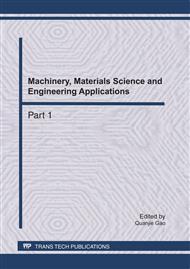p.253
p.259
p.265
p.270
p.276
p.283
p.288
p.293
p.299
The Weight Distribution and Configurability of Process Collaboration
Abstract:
Based on the process reuse, a great number of process chains in a computer aided process planning (CAPP) system can form into a large process network as a collection of process collaborations with a large weight and processes with a larger strength. This paper aims to study the topological structure, weighted connectivity and assortativity, and configurability analysis of a realistic turbine process network. The empirical analysis indicates that the nonequilibrium weight distribution reveals a decaying power-law behavior, whereas the weight assignment of process collaborations behaves randomly, and has an assortative relationship with degrees of quite a few processes. In this paper, an evaluation method of configurability of process couples is proposed based on assortativity, and then the process configurability can be classified into the strong and weak ones.
Info:
Periodical:
Pages:
276-282
Citation:
Online since:
April 2011
Authors:
Keywords:
Price:
Сopyright:
© 2011 Trans Tech Publications Ltd. All Rights Reserved
Share:
Citation:


